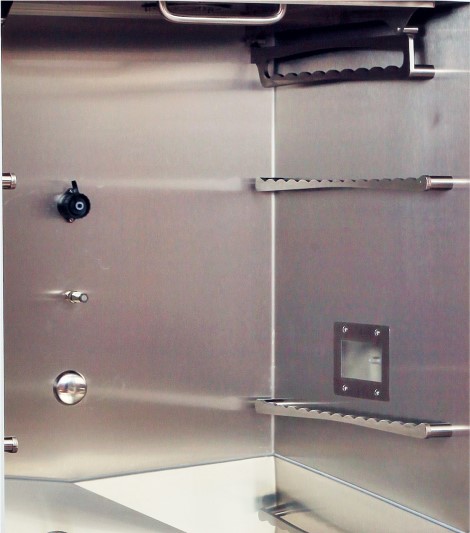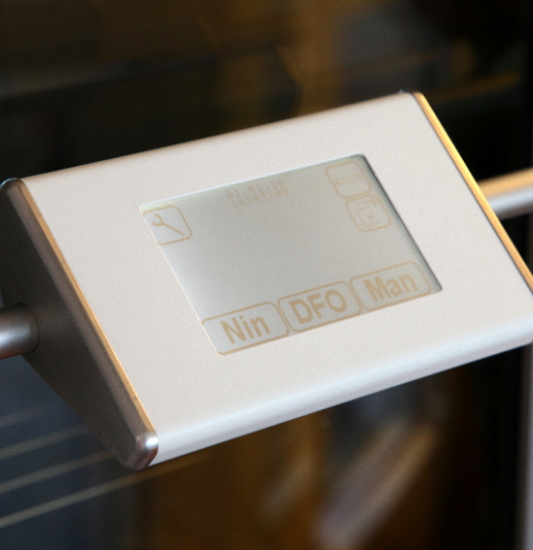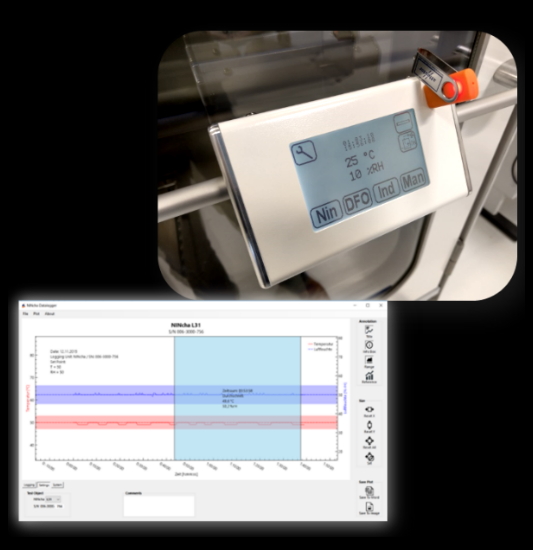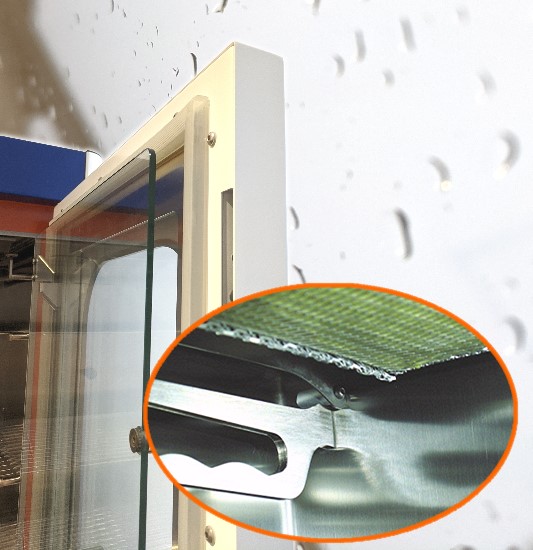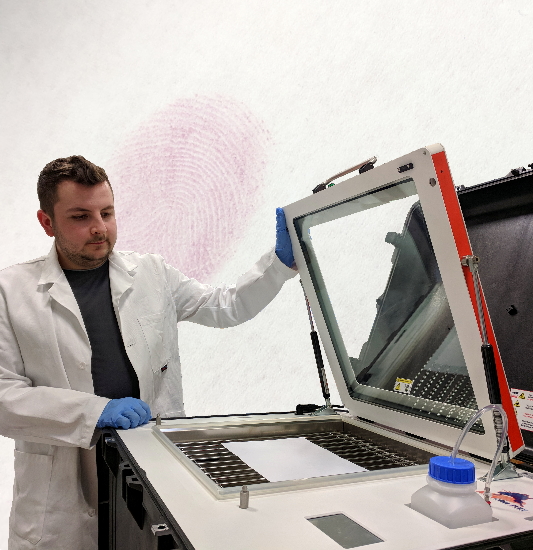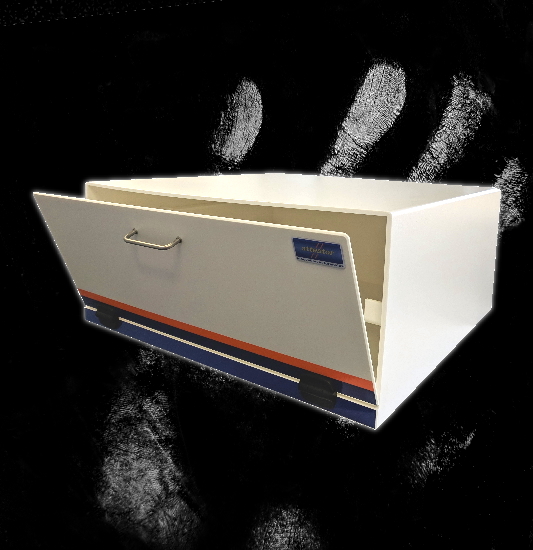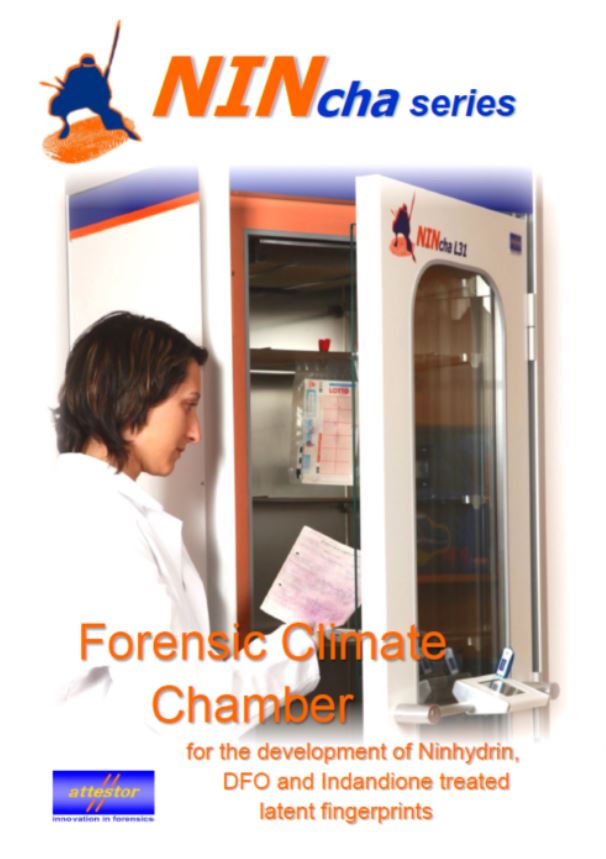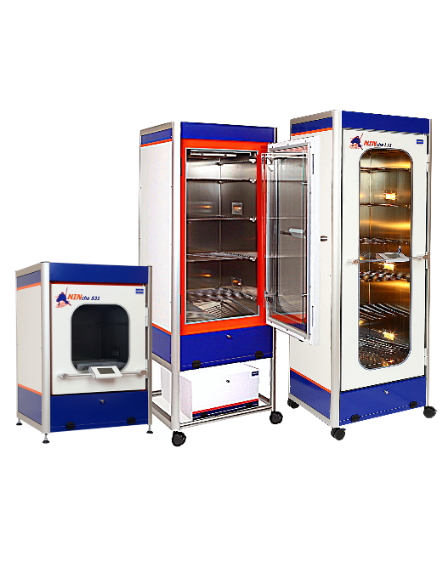
NINcha
- Ninhydrin, DFO and Indandion Development Chambers for Latent Fingerprints on porous surfaces
NINcha
is a climate chamber specially designed for developing fingerprints and similar marks on porous surfaces. There are three sizes of chamber in this series, the benchtop
model NINcha S31, the mid-size standing model,
NINcha M31 and the larger standing model,
NINcha L31.
Evidence with fingerprints is treated in the usual way by dipping or spray with developer like Ninhydrin, DFO or Indandione, and after an evaporation step, is developed
in a climate chamber. This allows the evidence to be developed under the ideal temperature and humidity conditions for the best results.
Many laboratories attempt to do the development step in a cabinet or chamber designed for other uses. These, unfortunately, are not ideal for evidence development.
Not only can they produce inferior results, less standardized methods threaten laboratory credibility, and use of improper equipment can contaminate evidence and even cause it
to develop mold.
NINcha was specially developed for forensic laboratory use,
using the feedback of professionals working in the field. With over 500 systems installed worldwide, NINcha is a hallmark of modern day forensic equipment standards for fingerprint development on porous surfaces.
All NINcha series models are constructed with the same
innovative details in mind, using future-proofed state-of-the-art production techniques.
Product Details
Learn more about the special features of this product. Simply click to the image and browse through the features.
Frequently Asked Questions
Here you find answers for the most frequently asked questions for this product.
Did you not find your particular question or is the answer not satisfactory?
Then please feel free to contat us by email or use the contact form below.
-
How do I clean the
NINcha interior?
During the development process, dust can be created by evidence and settle on the interior surface of climate chambers.
NINcha reduces this dust with a specialized filter system (Ninhydrin filter is included with a standard order, but additional optional filters for IND and DFO are also available).
In addition to using the filter system to reduce dust, the chamber interior should still be frequently cleaned to prevent DNA contamination.
The stainless steel and glass interior of the chamber can be wiped with a damp microfiber cloth, or a mild water and soap solution. It can also be wiped or sprayed with an alcohol or peroxide solution for DNA decontamination. -
How often should I refill the distilled water reservoir
and how do I refill it?
Each NINcha has an internal integrated reservoir sized according to the chamber size. This reservoir must be refilled only with demineralized water to prevent mineral buildup from clogging the system.
How often the reservoir will need to be refilled will be dependent on how often the system it is used and how it is used, as different cycles will use more water. Cycles with more evidence and settings that require higher humidity levels will use more water than cycles with less evidence and lower humidity levels. Temperature can also affect the amount of water used.
The unit will indicate when water levels are low and when to refill the reservoir. The reservoir can be refilledy using the reservoir suction hose located behind the front panel of the unit, below the door to the chamber. The suction hose has a shutoff valve and debris filter and should still only be used with clean filtered water.
When the hose is inserted into a container of fresh water for the reservoir and the valve is opened, users can select the option on the display to automatically begin refilling the reservoir. The reservoir will continue to fill until it reaches the maximum fill level, at which point it will shut off the suction. The hose valve can then be closed and the hose can be stowed back in the storage space behind the access panel. -
How long will the parameters in my cabinet take to reach
their setpoints, and how long will it take for the parameters to return to their setpoints if I need to open the door?
There is no set time for this, as the amount of time required will depend highly on the setpoints selected and ambient conditions. In general, it will take longer to reach higher temperature and humidity levels. This time may be shorter if ambient temperature and humidity are higher.
The NINcha was designed specifically to avoid dramatic overshooting or instability around setpoints in order to prevent damage to evidence or unpredictable development. Climate chambers that have poor accuracy and display frequent overshooting behavior can develop condensation in the chamber and can result in poor evidence development and clarity, especially in cases where the evidence is exposed to conditions over 85°C and 80% rH.
Units that heat and humidify quickly have a tendency to overshoot. We at Attestor have worked closely with customers to develop a chamber that has steadier and more predicatable changes in parameters to prevent problems like this and ensure that the NINcha units do not exceed cricital levels of temperature or humidity that could damage evidence, while still providing a climate chamber that reaches setpoints in a reasonable amount of time to not hamper typical laboratory operation. -
What maintenence does the NINcha require?
NINcha is a very low maintenance system, like many of our other systems. Aside from regular cleaning and changing the filters, users generally only need to refill the water reservoir and empty out the wastewater reservoir. How often the reservoir will need to be refilled will depend on how often the NINcha is used and what parameters it uses during cycles. The system will indicate when it is time to refill the reservoir. This is easily done with the automatic reservoir filling system. The wastewater reservoir collects condensation and other moisture from the chamber during cycles. This looks like a small drawer and is located behind ther front access panel of the unit. It can easily be removed to dump out any accumulated water. The reservoir should be emptied and rinsed every few days to keep it clean.
For quality assurance, we recommend that the unit be serviced regularly by an Attestor or Attestor certified partner.
For customers who require documented annual servicing and calibration as part of their ISO 17025 accreditation, we offer service contracts for regular service. These can also include parts warranties if desired. More information on this can be found under Service & Maintenance
Product Downloads
Download the product brochure as a pdf file or check out the product video. Some of our videos we offer for direct download from our server.
If your internet speed is restricted, you may want to watch the video via our YouTube channel.
Related Products
These products are often in use with the above product or are used in the same field of application.
Our Contact-Form
Do you require further information, a product demonstration or budget pricing?
Just contact us by email or the contact form.
Click on a branch address below the contact form to view the location on a map..
Call Us
Germany
+49 (0) 7564 - 949 14 - 0
United States
+1 215-804-4092

